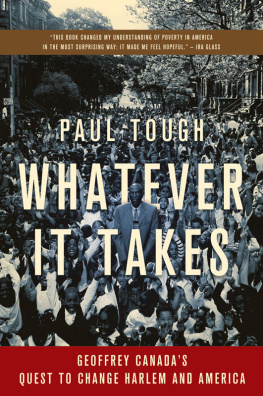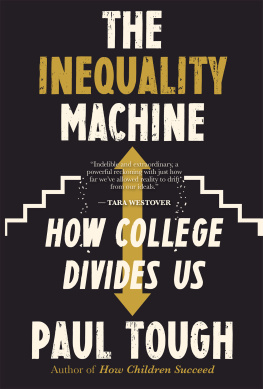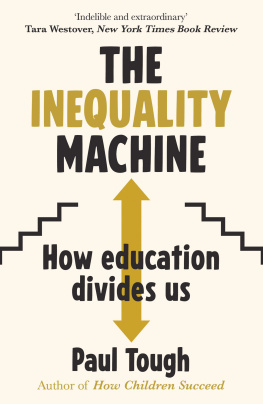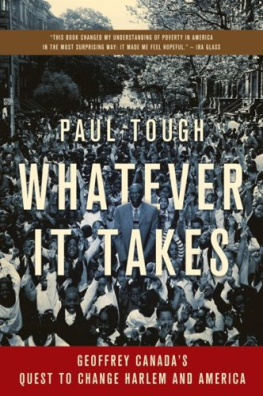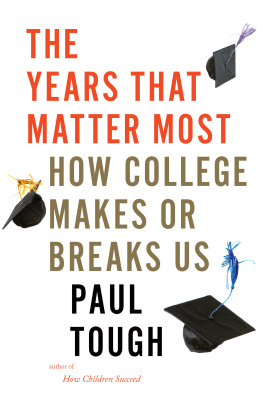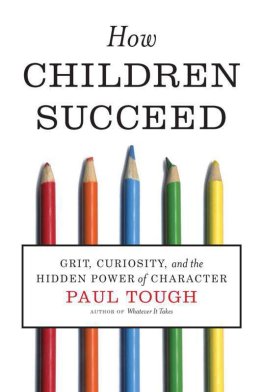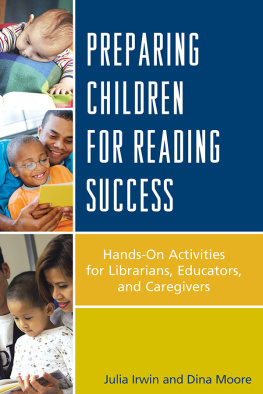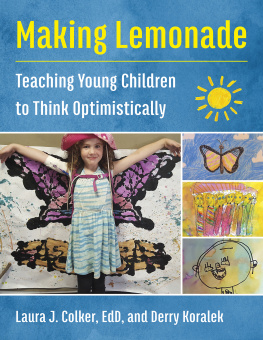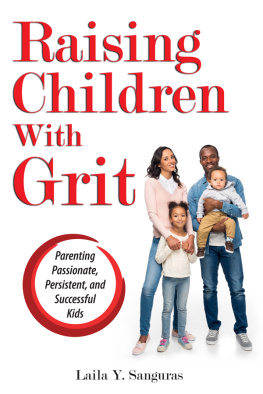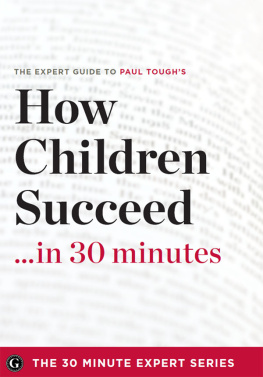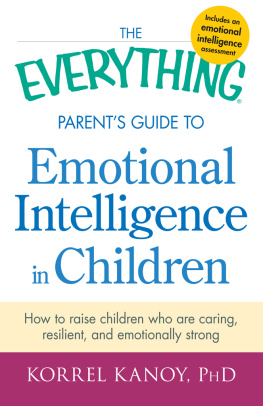Copyright 2012 by Paul Tough
All rights reserved
For information about permission to reproduce selections from this book, write to Permissions, Houghton Mifflin Harcourt Publishing Company, 215 Park Avenue South, New York, New York 10003.
www.hmhbooks.com
The Library of Congress has cataloged the print edition as follows:.
ISBN 978-0-547-56465-4
Portions of this book first appeared in the New York Times Magazine and The New Yorker.
e ISBN 978-0-547-56466-1
v1.0912
For Ellington, who prefers books about dump trucks
Introduction
In the summer of 2009, a couple of weeks after my son, Ellington, was born, I spent the day in a prekindergarten classroom in a small town in New Jersey. The two events were unrelatedI was visiting room 140 at the Red Bank Primary School not to scope out the class as a new parent but to try to understand it as a journalist. At first glance, the classroom seemed entirely ordinary. The cinder-block walls were painted a cheery yellow; an American flag stood next to the whiteboard. Around the room, four-year-olds were happily engaged in the customary diversions of pre-K students: building towers of Legos and driving trucks through sand tables and piecing together jigsaw puzzles. But as the day progressed, I realized that what was going on in room 140 was in fact quite unusual, in ways both self-evident and subtle. To begin with, the students were remarkably calm and orderly. There were no tears that day, no meltdowns, no tantrums, no fights. Oddly, though, the teacher, a young, dark-haired woman named Ms. Leonardo, didnt seem to be going out of her way to maintain order, or even to guide the childrens conduct in any overt fashion. There were no admonitions, no gold stars, no time-outs, no I like the way Kellianne is paying attention!indeed, no rewards for good behavior or punishments for bad at all.
The students in room 140 were enrolled in a program called Tools of the Mind, a relatively new kindergarten and prekindergarten curriculum that was created by two educators in Denver and based on an unorthodox theory of child development. Most early-childhood classrooms in the United States today are designed to develop in children a set of specific pre-academic skills, mostly related to deciphering text and manipulating numbers. Tools of the Mind, by contrast, doesnt focus much on reading and math abilities. Instead, all of its interventions are intended to help children learn a different kind of skill: controlling their impulses, staying focused on the task at hand, avoiding distractions and mental traps, managing their emotions, organizing their thoughts. The founders of Tools of the Mind believe that these skills, which they group together under the rubric self-regulation, will do more to lead to positive outcomes for their students, in first grade and beyond, than the traditional menu of pre-academic skills.
Tools of the Mind students are taught a variety of strategies, tricks, and habits that they can deploy to keep their minds on track. They learn to use private speech: talking to themselves as they do a difficult task (like, say, forming the letter W), to help them remember what step comes next (down, up, down, up). They use mediators: physical objects that remind them how to complete a particular activity (for instance, the two cards, one with a pair of lips and one with an ear, that signify whose turn it is to read aloud in buddy reading and whose turn it is to listen). Every morning, they fill out play plans, forms on which they write or draw descriptions of that days play: I am going to drive the train; I am going to take the dollies to the beach. And they spend long hours engaged in mature dramatic play: extended, complex make-believe scenarios that the designers of Tools of the Mind believe naturally teach children how to follow rules and regulate impulses.
As I watched the kids in room 140, I found myself thinking, inevitably, about Ellington, the tiny life form cooing and burping and wailing away thirty miles to the north, in our studio apartment in Manhattan. I knew I wanted him to have a happy, successful life, but I didnt really know what, exactly, I meant by that, or just what my wife and I were supposed to be doing to help guide him there. I wasnt alone in my confusion. Ellington was born into a particularly anxious moment in the history of American parenting. And that anxiety had grown especially keen in cities like New York, where the competition over slots in favored preschools verged on the gladiatorial. A pair of economists from the University of California recently dubbed this nationwide contest for early academic achievement the Rug Rat Race, and each year, the race seems to be starting earlier and growing more intense. Two years before Ellingtons birth, the Kumon chain of tutoring centers opened New York Citys first Junior Kumon franchise, where children as young as two spent their mornings filling out worksheets and completing drills on letter and number recognition. Age 3 is the sweet spot, Kumons chief financial officer told a reporter for the New York Times. But if theyre out of a diaper and can sit still with a Kumon instructor for 15 minutes, we will take them.
Ellington would be growing up in a culture saturated with an idea you might call the cognitive hypothesis: the belief, rarely expressed aloud but commonly held nonetheless, that success today depends primarily on cognitive skillsthe kind of intelligence that gets measured on IQ tests, including the abilities to recognize letters and words, to calculate, to detect patternsand that the best way to develop these skills is to practice them as much as possible, beginning as early as possible. The cognitive hypothesis has become so universally accepted that it is easy to forget that it is actually a relatively new invention. You can trace its contemporary rise, in fact, to 1994, when the Carnegie Corporation published Starting Points: Meeting the Needs of Our Youngest Children, a report that sounded an alarm about the cognitive development of our nations children. The problem, according to the report, was that children were no longer receiving enough cognitive stimulation in the first three years of life, in part because of the increasing number of single-parent families and working mothersand so they were arriving in kindergarten unready to learn. The report launched an entire industry of brain-building zero-to-three products for worried parents. Billions of dollars worth of books and activity gyms and Baby Einstein videos and DVDs were sold.
The Carnegie findings and the studies that followed in their wake had a powerful effect on public policy, too, as legislators and philanthropists concluded that disadvantaged children were falling behind early on because of insufficient cognitive training. Psychologists and sociologists produced evidence linking the academic underperformance of poor children to a lack of verbal and mathematical stimulation at home and at school. One of the most famous of these studies (which I wrote about in my first book, Whatever It Takes) was conducted by Betty Hart and Todd R. Risley, two child psychologists who, beginning in the 1980s, intensively studied a group of forty-two children from professional, working-class, and welfare families in Kansas City. Hart and Risley found that the crucial difference in the childrens upbringings, and the reason for the divergence in their later outcomes, boiled down to one thing: the number of words that the children heard from their parents early in life. By age three, Hart and Risley determined, the children raised by professional parents had heard thirty million words spoken to them; the children with parents on welfare had heard just ten million. That shortfall, they concluded, was at the root of the poorer kids later failures in school and in life.
Next page
